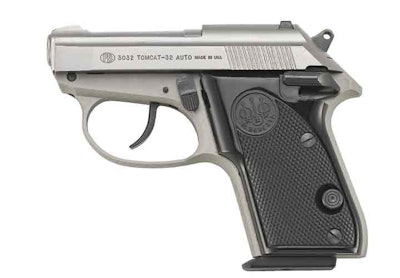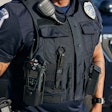 Photo by Butch Simpson.
Photo by Butch Simpson.
Editor's note: View our "Beretta's 3032 Tomcat Pistol" photo gallery for detailed photos of the pistol.
Fabbrica d'Armi Pietro Beretta of Gardone Val Trompia, Brescia, Italy, is one of the world's oldest privately owned firearms manufacturers. Founded by master gunsmith Bartolomeo Beretta in 1526, Beretta's product line has over the centuries included every conceivable type of firearm from the earliest matchlocks to the most modern assault rifles. But since 1915 the company has probably been best known for its handguns.
During World War I Beretta produced a line of blowback-operated 7.65mm (.32 ACP) semi-auto pistols that were widely used by the Italian and various Allied armies. The years after the war saw Beretta develop a series of 6.35mm (.25 ACP), 7.65mm, and 9mm Corto (.380 ACP) pistols that gained worldwide acceptance by civilians, police, and the military. Improved models were introduced at the end of World War II, including subcompact pistols in .22 Short and .22 LR. Then in 1951, the company produced its first locked-breech design in 9mm Parabellum, which evolved into the present day Beretta Model 92.
Today the Model 92 gets all the attention, but Beretta has not forgotten its roots and still offers a number of blowback-operated, sub-compact pistols.
In 1984 the company introduced the Model 21A Bobcat chambered in .22 LR and .25 ACP. The Bobcat was unique among the breed of so-called "mouseguns" in that it had a DA/SA trigger mechanism, but its most revolutionary feature was a tip-up barrel. Of necessity, blowback-operated pistols have rather strong recoil springs and the tip-up barrel allowed the shooter to load and unload the pistol without having to rack the slide. This was not only convenient but a major bonus for those with small or weaker hands.
While the Bobcat proved popular with both armed civilians and as a backup gun with police, there were those who wanted a similarly sized pistol that fired a more powerful cartridge. To address these requests, Beretta introduced the 3032 Tomcat chambered for the .32 ACP.
Developed in the 1890s by John Moses Browning for Fabrique Nationale's Mle. 1900 pistol, the 7.65mm Browning (.32 ACP) utilized a semi-rimmed case 17mm long with a 71-grain full-metal-jacketed (FMJ) bullet that is propelled to a muzzle velocity of approximately 900 feet per second.
The .32 ACP was well suited to blowback-operated pistols and was immediately embraced by European military and police forces. In the more turbulent 1990s most European police agencies switched to 9mm pistols, although .32 ACP handguns are still widely used by Continental undercover officers. Before WWII .32 caliber pistols produced in the U.S. by Colt, Harrington & Richardson, Savage, and Remington also saw limited use by American undercover officers.
Tip-Up Barrel
The .32 ACP Beretta Tomcat is an extremely small concealed carry pistol that some officers use for backup and off-duty carry. Features include an alloy frame and forged blue steel slide (stainless steel is optional), external hammer, tip-up barrel, and manual safety. The open top slide—a Beretta feature since 1915—reduces the likelihood of a spent case hanging up during ejection.
To load the Tomcat, you rotate a lever on the left side of the frame, releasing the barrel and allowing it to pivot up. The round is then inserted into the chamber and the barrel pushed down until it locks into the frame once again.
To unload you release the barrel and either pull the loaded cartridge out manually or tilt the muzzle up and let it fall out. The Tomcat lacks an extractor, relying upon expanding powder gases to force the spent case rearward and eject it from the pistol. This means that racking the slide will not remove either unspent or defective cartridges.
Unlike most DA/SA pistols, the Tomcat does not have a hammer drop mechanism, which means that the hammer must be lowered manually (carefully!) on a loaded chamber. An external thumb safety allows the option of cocked-and-locked carry, but Beretta does not recommend it. Note: The safety can be applied with the hammer forward, which prevents hammer and slide movement.
The single column, seven-round magazine is retained by a catch countersunk in the right-hand grip panel and is fitted with an extended base plate for positive extraction.
Really? .32 ACP?
Is a .32 ACP pistol a viable choice for a backup/off duty weapon? That's a question that is not so easy to answer. On the plus side, contemporary self-defense ammunition manufacturers such as Winchester, Speer, Federal, Cor-Bon, and Hornady offer a variety of jacketed hollow point (JHP) .32 ACP rounds that include expanding bullets at higher velocities.
But this leads us to an ammunition controversy. It is held by some that when using the .32 ACP an FMJ projectile is preferred over an expanding JHP bullet. These shooters argue that an FMJ is more likely to penetrate clothing and soft tissue with enough energy remaining to penetrate into vital organs. It has been suggested that with expanding bullets a majority of the projectile's energy will be expended as it travels through clothing and tissues, lessening its chances of damaging vital organs.
On paper the performance of the various JHP loads are similar to that of the FMJ, so it's going to be up to individual officers to decide what best serves their purposes.
Test Firing
The Tomcat I received for this evaluation was a chunky little pistol with a reassuring heft. Ergonomics were excellent, and I really liked that the thumb safety could be manipulated without moving the pistol around in your hand.
The DA trigger stroke was fairly stiff, but considering the ranges the Tomcat is likely to be used at, I do not see that as a downside. According to my RCBS trigger pull scale, the SA trigger broke crisply, after a bit of take up, at six pounds.
My pistol was fitted with the optional Trijicon front sight with a tritium insert for use in low light. The rear sight is a shallow V "express sight" with a white bar. This combination provides very fast sight acquisition and alignment for close range shooting.
Considering the pistol's size, likely use, and the style of the sights, I felt that trying to shoot tight little groups from a rest would be an exercise in futility. Accordingly, test firing consisted of running a series of drills on a combat target at a practical distance of five yards.
I fired the Tomcat in both DA and SA modes, with supported and unsupported (one-handed) grips, and was pleasantly surprised by its performance. Every single round I fired found its way into the higher scoring areas of the target. And yes, that's where I was aiming.
Despite my preconceptions, recoil was very controllable and fast, and accurate follow-up shots could be performed effortlessly. Early in the test firing I experienced two failures to chamber with the Winchester ammo, both times the last round in the magazine. After that everything else fed, fired, and ejected smoothly.
I only have two major criticisms about the Tomcat. First, the edges of the trigger are sharp, and I would suggest that Beretta bevel these to correct this problem. Second, I would like to see a finger rest magazine base plate offered as an option. It would not compromise concealability to any degree but would allow a full three-finger grip for enhanced recoil control.
All in all I found the Tomcat to be reliable, compact, easy to conceal, easy to use, and adequately accurate. It fits the bill as a backup or off-duty pistol very well, as long as you understand and accept the limitations of the .32 ACP cartridge.
Paul Scarlata has served as an auxiliary police officer and is a frequent contributor to POLICE.

















